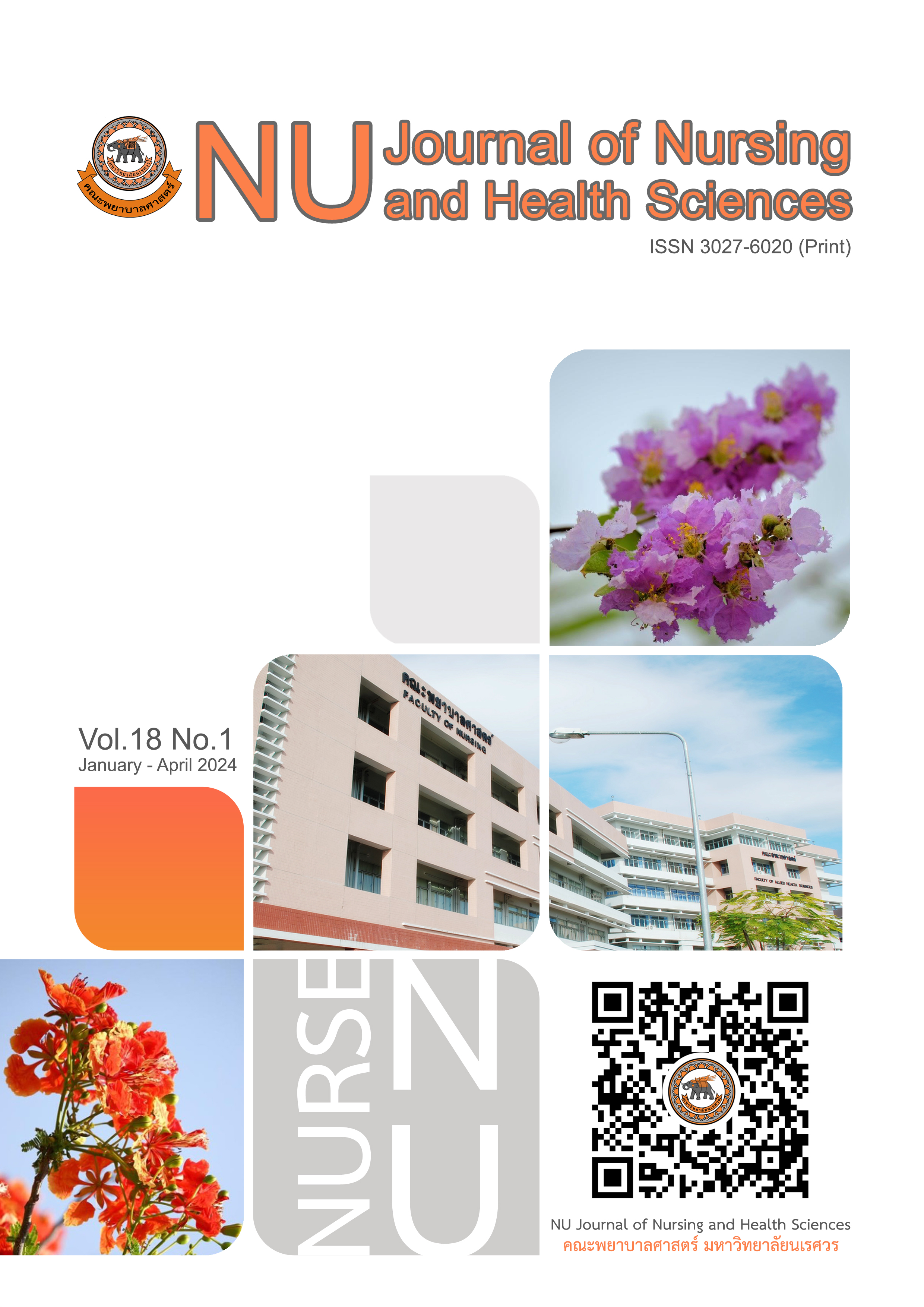ปัจจัยทำนายกลุ่มอาการภายหลังสมองได้รับการกระทบกระเทือนในผู้ป่วยบาดเจ็บที่ศีรษะระดับเล็กน้อย
Main Article Content
บทคัดย่อ
ผู้ป่วยบาดเจ็บที่ศีรษะระดับเล็กน้อยมักเกิดกลุ่มอาการภายหลังสมองได้รับการกระทบกระเทือน หากไม่ได้รับการแก้ไขอาจส่งผลให้ผู้ป่วยมีการฟื้นฟูสภาพได้ช้าลง การวิจัยครั้งนี้มีวัตถุประสงค์เพื่อศึกษาปัจจัยทำนาย ได้แก่ ความปวด การมีโรคร่วมก่อนการบาดเจ็บ ความวิตกกังวล แรงสนับสนุนทางสังคม และประวัติการดื่มแอลกอฮอล์ กับกลุ่มอาการภายหลังสมองได้รับการกระทบกระเทือน กลุ่มตัวอย่างเป็นผู้ป่วยบาดเจ็บที่ศีรษะระดับเล็กน้อยที่มาตรวจตามนัด ณ แผนกผู้ป่วยนอกศัลยกรรม โรงพยาบาลตติยภูมิแห่งหนึ่ง ในเขตภาคเหนือตอนล่าง ของประเทศไทย คัดเลือกกลุ่มตัวอย่างตามคุณสมบัติที่กำหนด ด้วยวิธีจำเพาะเจาะจง จำนวน 110 ราย เครื่องมือที่ใช้ในการวิจัย ประกอบด้วย 1) แบบสอบถามข้อมูลส่วนบุคคล 2) แบบวัดความปวดชนิดที่เป็นตัวเลข 3) แบบวัดความวิตกกังวลขณะเผชิญปัญหาของผู้ป่วย ได้ค่าความเชื่อมั่นเท่ากับ .82 4) แบบสอบถามแรงสนับสนุนทางสังคม ได้ค่าความเชื่อมั่นเท่ากับ .78 5) แบบสอบถามอาการภายหลังสมองได้รับการกระทบกระเทือน ได้ค่าความเชื่อมั่นเท่ากับ .88 วิเคราะห์ข้อมูลโดยใช้สถิติเชิงพรรณาและวิเคราะห์ถดถอยพหุคูณผลการศึกษาพบว่า ปัจจัยที่สามารถร่วมกันทำนายกลุ่มอาการภายหลังสมองผู้ป่วยบาดเจ็บที่ศีรษะระดับเล็กน้อยได้แก่ ความปวด (β = .49) และความวิตกกังวล (β = .42) โดยอธิบายความแปรปรวนได้ร้อยละ 49 (Adjust R2 = .49,p < .05) ข้อค้นพบที่ได้จะเป็นข้อมูลพื้นฐานสำคัญในการป้องกันหรือบรรเทาอาการภายหลังสมองได้รับความกระทบกระเทือนในผู้ป่วยบาดเจ็บศีรษะระดับเล็กน้อย เพื่อให้ผู้ป่วยสามารถฟื้นฟูสภาพได้ดี และดำเนินชีวิตตามปกติภายหลังเกิดการบาดเจ็บที่ศีรษะ
Article Details

อนุญาตภายใต้เงื่อนไข Creative Commons Attribution-NonCommercial-NoDerivatives 4.0 International License.
เอกสารอ้างอิง
Caruso, M. A. (2020). Posttraumatic stress disorder and post concussion syndrome in relation to the
alcohol use among members of the armed force who served in operation enduring
freedom/operation Iraqi freedom. Master Thesis (Science Clinical Psychology), Alabama, USA.
Center for Disease and Control Prevention. (2020). Traumatic brain injury & concussion. Retrieved
February 2022 from https://www.cdc.gov/traumaticbraininjury/ index.html
Deethongkham, D., Masingboon, K., & Kunsongkeit, W. (2015). Relationships between post concussion
symptoms and functional performance in patients with mild traumatic brain injury. Dissertation,
Burapha University, Chonburi. [In Thai]
Fikriyanti, Kitrungrote, L., & Songwathana, P. (2014). The post concussion symptom experience, post
concussion symptom management, and quality of life in persons with mild traumatic brain injury in
Indonesia. Songklanagarind Journal of Nursing, 34(2), 1-15. [In Thai].
Fong, A. (2023). Post-concussion syndrome treatment: therapy & medications. Retrieved 3 March 2023
from https://www.cognitivefxusa.com/blog/post-concussion-syndrome-treatment-what-to-know.
Georges, A., & Booker, JG. (2019). Traumatic brain injury. Treasure Island (FL): StatPearls.
Hou, R., Moss-Morris, R., Peveler, R., Mogg, K., Bradley, B. P., & Belli, A. (2012). When a minor head injury
results in enduring symptoms: a prospective investigation of risk factors for postconcussional
syndrome after mild traumatic brain injury. Journal of neurology, neurosurgery, and psychiatry,
(2), 217-223.
Jampawal, T. (2018). State anxiety. Buddhist psychology journal, 3(1), 14-19.
Jensen, M. P., Karoly, P., & Braver S. (1986). The measurement of clinical pain intensity: a comparison of six
methods. The Journal of the International Association for the Study of Pain, 27(1), 117–126.
King, N. S., Crawford, S., Wenden, F. J., Moss, N. E., & Wade, D. T. (1995). The rivermead post concussion
symptoms questionnaire: a measure of symptoms commonly experienced after head injury and its
reliability. Journal of Neurology, 242(9), 587-592.
Kinklaykan, K., & Jitpanya, C. (2019). Relationships among pain, anxiety, social support, and post concussive
syndromes. Chula Med Bull, 1(5), 440-449. [In Thai]
Lee, S. E., Vincent, C., & Finnegan, L. (2017). An analysis and evaluation of the theory of unpleasant
symptoms. Advances in Nursing Science, 40(1), E16-E39.
Lenz, E. R., Pugh, L. C., Milligan, R. A., Gift, A., & Suppe, F. (1997). The middle-range theory of unpleasant
symptoms: An update. Advances in Nursing Science, 19(3), 14-27.
McInnes, K., Friesen, C. L., MacKenzie, D. E., Westwood, D. A., & Boe, S. G., (2017). Mild traumatic brain
injury (mTBI) and chronic cognitive impairment: a scoping review. PLOS ONE, 14(6), e0218423.
Melzack, R., & Wall, P. D. (1965). Pain mechanisms: a new theory. Science (New York, N.Y.), 150(3699),
–979.
Permenter, C. M., Fernández-de Thomas, R. J., & Sherman, A. I. (2023). Postconcussive syndrome. Treasure
Island (FL): StatPearls.
Polinder, S., Cnossen, M. C., Real, R. L., Covic, A., Gorbunova, A., Voormolen, D. C., … Steinbuechel, N. V.
(2018). Multidimensional approach to post-concussion symptoms in mild traumatic brain injury.
Frontiers in Neurology, 9, 1113.
Premsai, T., Siripo-Ngam, Y., & Putwatana, P. (2003). Follow up study of patient’s adaptation after mild head
injury. Dissertation, Mahidol University, Nakorn Pratom. [In Thai].
Royal College of Surgeons of Thailand. (2013). Clinical practice guidelines for traumatic brain injury.
Bangkok: Thana Press.
Ruangritchankul, S., & Krairit, O. (2018). Chronic pain assessment in the elderly. Ramathibodi Medical
Journal, 41(3), 92-99. [In Thai]
Schaefer, C., Coyne, J. C., & Lazarus, R. S. (1981). The health-related functions of social support. Journal
Behavior Medcine, 4(4), 381-406.
Spielberger, C. D. (1976). The nature and measurement of anxiety. Washington DC: Hemisphere.
Srisatidnarakul, B. (2007). The methodology in nursing research. Bangkok: U & I Inter Media. [In Thai].
Thapinta, D., Imsupasit, S., & Malakul P. (1991). Reduction of anxiety of staff nurses working with AIDS patients
through cognitive reconstructuring and mindfulness training. Master Thesis, Chulalongkorn University,
Bangkok. [In Thai]
Utley, J., & Arvinen-Barrow, M. (2017). Managing mental health aspects of post-concussion syndrome in
collegiate student-athletes. Athletic Training & Sports Health Care, 9(6), 263-270.
Varriano, B., Tomlinson, G., Wennberg, R., Tarazi, A., Tator, C. & Tartaglia M. C. (2018). Age, gender and
mechanism of injury interactions in post-concussion syndrome. The Canadian journal of
neurological sciences. Le journal canadien des sciences neurologiques, 45(6), 636–642.
Wongchai, N., Varitsakul, R., & Tantivesruangdet, N. (2022). Factors associated with post-concussion syndrome
in patients with mild traumatic brain injury after discharging from an emergency department.
Nursing journal CMU, 49(2), 252-269. [In Thai]
Yue, J. K., Cnossen, M. C., Winkler, E. A., Deng, H., Phelps, R. R. L., Coss, N. A., … TRACK-TBI Investigators (2019).
Pre-injury comorbidities are associated with functional impairment and post-concussive symptoms
at 3- and 6-months after mild traumatic brain injury: a TRACK-TBI study. Frontiers in Neurology,
, 343.
Zeng, E., Zeng, B., Tian, J., Du, B., Tian, X., & Chen, H. (2016). Perceived social support and its impact on
mental fatique in patients with mild traumatic brain injury. Ballkan Medicine Journal, 33(2),
-157.


